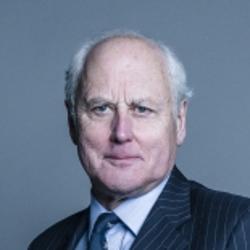
3 APPG Officer Positions (as of 9 Sep 2025)
Charities and Volunteering, Modern Conflict, Outdoor Recreation and Access to Nature4 APPG Memberships
Beer, Financial Education for Young People, Future of Work, University10 Former APPG Officer Positions
'Left Behind' Neighbourhoods, Building Communities, Civil Society and Volunteering, Drones, Drones and Modern Conflict, Extraordinary Rendition, Penal Affairs, Restorative Justice, University, War HeritageDivision Voting information
Lord Hodgson of Astley Abbotts voted Aye - against a party majority and against the House
One of 33 Conservative Aye votes vs 39 Conservative No votes
Tally: Ayes - 83 Noes - 129
Debates during the 2024 Parliament
Speeches made during Parliamentary debates are recorded in Hansard. For ease of browsing we have grouped debates into individual, departmental and legislative categories.
Sparring Partners
Baroness in Waiting (HM Household) (Whip)
(3 debate interactions)
Shadow Minister (Environment, Food and Rural Affairs)
(3 debate interactions)
(3 debate interactions)
Department Debates
(22 debate contributions)
(2 debate contributions)
(2 debate contributions)
(1 debate contributions)
Legislation Debates
(5,359 words contributed)
(3,491 words contributed)
(706 words contributed)
(565 words contributed)
Lords initiatives
These initiatives were driven by Lord Hodgson of Astley Abbotts, and are more likely to reflect personal policy preferences.
1 Bill introduced by Lord Hodgson of Astley Abbotts
A Bill to establish the Office for Demographic Change with the duty of collecting evidence about and analysing the impact of population change, and considering future changes in the population of the United Kingdom and their consequences; and for connected purposes
Lord Hodgson of Astley Abbotts has not co-sponsored any Bills in the current parliamentary sitting
Latest 7 Written Questions
(View all written questions)2 Department for Work and Pensions Questions
(View all Lord Hodgson of Astley Abbotts's DWP questions)The information requested is not readily available and to provide it would incur disproportionate cost.
Minister of State (Department for Work and Pensions)
The Department publishes quarterly statistics on National Insurance number allocations to adult overseas nationals entering the UK with the latest statistics to June 2024 available by world area and country on Stat-Xplore. The number issued in the 12 months to June 2024 by world areas is shown in the table below.
NINO Registrations To Adult Overseas Nationals Entering The UK
Nationality | Rolling year end June 2023/24 |
European Union | 69,927 |
Non-European Union (Other Europe) | 49,302 |
Asia | 544,241 |
Rest of the World | 261,711 |
Other / unknown | 14,857 |
Total | 940,039 |
Source: Stat-Xplore
Note: Statistical disclosure control has been applied to this table to avoid the release of confidential data. Totals may not sum due to the disclosure control applied.
Minister of State (Department for Work and Pensions)
1 Department of Health and Social Care Questions
(View all Lord Hodgson of Astley Abbotts's DHSC questions)The Department and NHS England do not hold this information. The statutory guidance on hospital discharge procedures, Hospital discharge and community support guidance, published in January 2024, sets out how local areas should plan and implement hospital discharge in order to support safe and timely discharge for all individuals. Further information on this guidance is available on the GOV.UK website, in an online only format.
Parliamentary Under-Secretary (Department of Health and Social Care)
1 Foreign, Commonwealth & Development Office Questions
(View all Lord Hodgson of Astley Abbotts's FCDO questions)In planning its operations, the Ministry of Defence takes the greatest possible care to minimise the risk of civilian casualties. Every mission carried out by Royal Air Force aircraft is assessed carefully, including for any evidence that civilian casualties resulting from British military action have been caused. All instances must be confirmed to Parliament.
On 29 April, UK forces participated in a joint operation with US forces against a Houthi military target in Yemen which careful intelligence analysis had identified was being used to manufacture long-range attack drones. This was the first UK strike on the Houthis since 30 May 2024, and was again conducted in self-defence and in line with the UK's longstanding policy.
We do not comment on other nations' military operations.
Lord in Waiting (HM Household) (Whip)
The Home Office publishes information on monthly Sponsored Study visa applications in the ‘Monthly entry clearance visa applications release’.
[Monthly entry clearance visa applications - GOV.UK (www.gov.uk)]
Data on Sponsored Study visa applications from main applicants and dependants can be found in the accompanying dataset.
[Monthly monitoring of entry clearance visa applications - GOV.UK (www.gov.uk)].
The Home Office also publishes quarterly data on Sponsored Study visas in the ‘Immigration Statistics Quarterly Release’ [Immigration system statistics quarterly release - GOV.UK (www.gov.uk)]. Data on visa applications, by applicant type and nationality, are published in table Vis_D01 of ‘Entry clearance visas granted outside the UK’ [Immigration system statistics data tables - GOV.UK (www.gov.uk)]. Information on how to use the dataset can be found in the ‘Notes’ page of the workbook. The latest data relates to Q2 (April to July) 2024.
Information on future Home Office statistical release dates can be found in the ‘Research and statistics calendar’ [immigration - Research and statistics - GOV.UK (www.gov.uk)].
Minister of State (Home Office)
2 Ministry of Defence Questions
(View all Lord Hodgson of Astley Abbotts's ministry-of-defence questions)We do not comment on other nations’ military operations but can confirm that the UK airstrike on 29 April 2025 was conducted against a Houthi military target in Yemen. The action was undertaken jointly with the US to uphold the freedom of navigation.
Minister of State (Ministry of Defence)
Ahead of the UK strikes in Yemen on 29 April, the utmost care was taken during planning to minimise any risk to civilians or non-military infrastructure.
This included conducting the strikes in the hours of darkness, as this was a feasible precaution available during this particular mission to further mitigate any such risks.
Minister of State (Ministry of Defence)